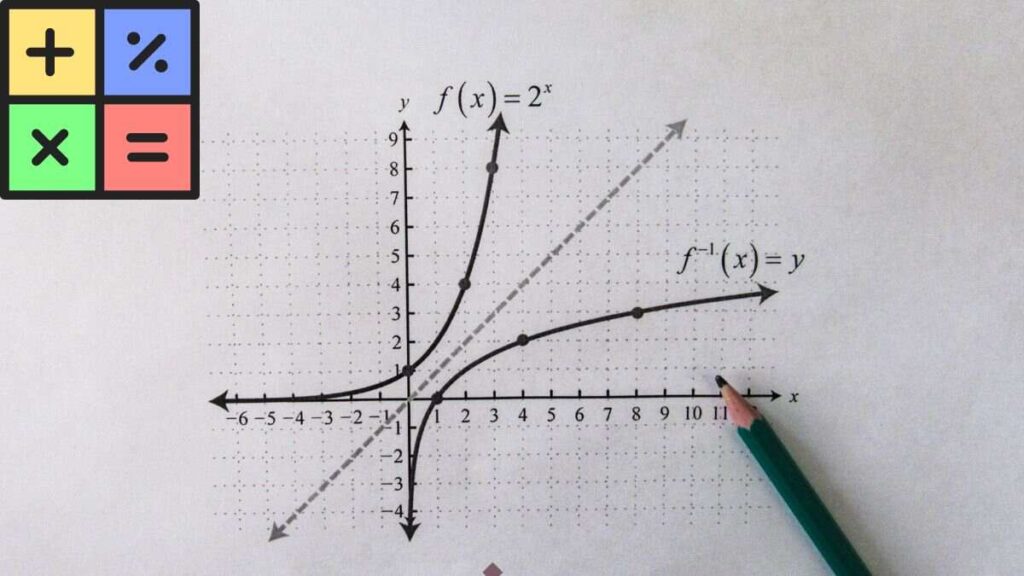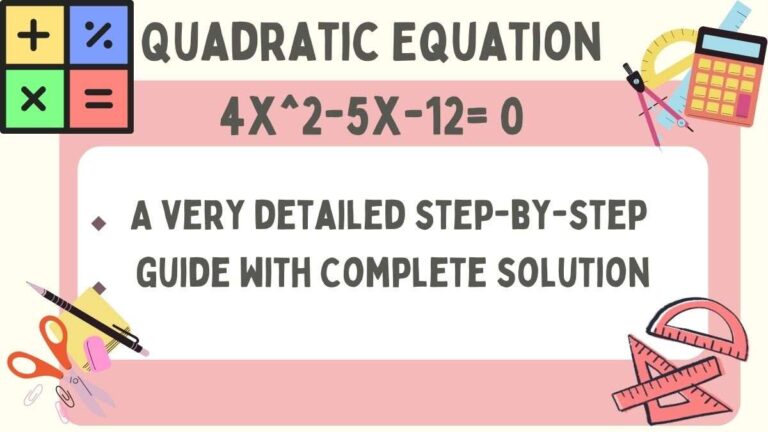Introduction
If you go through the subject of algebra, you’ll find innumerable complex quadratic equations. Possibly, 4x ^ 2 – 5x – 12 = 0 is one of them, which is also a part of fundamental concepts. Even the applications of it are found in fields beyond mathematics, such as physics, engineering, and finance. And since it is a quadratic equation, you must assume that solving would require high-end knowledge and intelligence. Yet, you must know 4x ^ 2 – 5x – 12 = 0 isn’t as complex or overwhelming, to say the least. Having said that, this article focuses on decoding the realm of quadratic equations. From components to solving tactics to real-world applications and so on — you can find everything here:
About Quadratic Equations and 4x ^ 2 – 5x – 12 = 0
A polynomial equation of the second degree indicates a quadratic equation. So, one squared term i.e., (x^2), has to be there. You can even see ‘(x^2)’ in the quadratic equation’s general form, ax^2 + bx + c = 0. Here, the value of ‘a’, ‘b’, and ‘c’ will be constants, while ‘x’ is the variable. It is additionally found that the equation -4x ^2 – 5x – 12 = 0 matches with the system perfectly.
What’s the usual type of a Quadratic Equation?
The equation -4x ^2 – 5x – 12 = 0 is only a fancier means of writing “ax^2 + bx + c = 0.” On it, we are looking for the variable x; while a, b, & c, aren’t supposed to confuse the solver.
- Simply put, finding the value of x that properly fits into the equation is the key. It looks pretty complicated, but as we move along the solution, you’ll see it untangle quite easily. And for the basics to be established, we’d have to look at the equation in a not-unusual shape.
- Now moving on to the equation of importance, i.e., 4x ^ 2 – 5x – 12 = 0, we’ll compare it to the ordinary “ax^2 + bx + c = 0”.
- Then try fitting the first with the latter and make them suit from start to end. Perhaps, 4 is a, 2 is b, and likewise, -6 represents c.
- The value of each also indirectly or directly gets supported by the core of the quadratic equation.
- Supposedly, every quadratic equation may have an answer through the unusual shape. Given this fact, working with the unusual shape should be the first thing to ponder.
- This applies to all, including math experts and non-serious buddies. Additionally, the standard form of a quadratic equation has to be remembered.
- Forgetting the same will result in the more complexity of identifying an equation’s leading coefficients.
- As already mentioned, the standard form is ax^2 + bx + c = 0, or we can say that it’s a route to solve other quadratic equations.
Perhaps, following this advice also means that you’ll become quite a master in distinguishing coefficients of ‘a’, ‘b’, and ‘c’. It is, furthermore, clear by now that values of a, b, and c are necessary to crack down an equation.
Factoring Quadratic Equations

Factoring quadratic equations is like fixing the issue, one step at a time and piece by piece.
- For those who wonder what factoring is about, just know it is the key to an unbreakable lock. Many also find factoring quadratic equations the best possible tactic for solving. Having said that, you’ll have to begin by taking an equation.
- Let’s proceed with — x ^ 2 + 5x + 6 — for now. Then, find two binomial phrases, followed by uncovering them. Do note the phrase should be such that when greater, a unique expression should be the outcome.
- This is an important stage, so assume that you are looking for the missing portions and consequently, solve the trouble.
- On a good note, solving x will be easy, now that you have the binomials. It is time to move ahead with x after binomials are in your hands. More precisely, the mystery of the equation will be solvable as you assort each binomial to 0 and observe the cost of x, such that the equivalent is 0.
- This particular move of factoring quadratic equations stands out as one of the easiest solving tactics.
- Plus, it is comparable to a superpower, so certainly knowing the process can give an upper hand. Although the quadratic machine is enough to crack down on the answer, you’ll be thankful afterward that factoring was included in your subject.
Step-by-step solution of -4x ^2 – 5x – 12 = 0 1200
To help you further in becoming a pro at quadratic equations like -4x ^2 – 5x – 12 = 0 1200, here’s an easier breakthrough:
Process 1: Factoring
Factoring is popular as one of the popular methods to solve quadratic equations or problems. The idea is to re-create the equation as one product of two binomials. Such as
Factoring is one of the primary method to solve quadratic equations.
4x^2 – 5x – 12 = 0
(2x + 3)(2x – 4) = 0
By placing each binomial to zero, we will find below solution:
2x + 3 = 0 OR 2x – 4 = 0
Solving for ‘x’ in every case we will have:
x = -3/2 OR x = 2
Process 2: Quadratic Formula Method
The quadratic formula offers a simple way to solve any quadratic equation. It can be solved by:
x = (-b ± √(b^2 – 4ac)) / 2a
For our equation, where a = 4, b = -5, and c = -12, the formula will be:
x = (5 ± √(25 + 192)) / 8
Further making it more simple:
x = (5 ± √217) / 8
Thus, the solution equation is:
x = (5 + √217) / 8 or x = (5 – √217) / 8
Graphical Representation of Quadratic Equations
- Vertex form
The vertex form of a quadratic equation is f(x) = a (x-h)^2+k in which the (h and k) shows the vertex of the parabola. The conversion of the equation 4x^2-5x-12= 0 into vertex form authorizes us to know the vertex and other necessary properties of the graph.
- Axis of Symmetry
It is a vertical line that goes through the vertex of the parabola and divides it into two different halves. Learning or understanding the Axis of Symmetry helps in sketching a graph accurately.
- Plotting the Graph
The graphical representation gives an intuitional visualization of the quadratic equation. We can observe the intersection of the parabola and its shape by plotting the graph.
Understanding the discriminant and nature of roots
If you want to learn about the nature of roots, particularly to understand quadratic equations; you’d have to first understand the discriminant (Δ). Perhaps, it is expressed as b^2 – 4ac. Also, the value of the discriminant is what distinguishes the roots to either be real and distinct, real and equal, or complex.
- Real and distinct roots: A quadratic equation will always have two distinct real roots whenever the discriminant is greater than zero i.e. (Δ > 0). Meaning, that the roots will represent the points where the equation has been intersecting on the x-axis on a graph.
- Real and equal roots: The quadratic equation will have two real but equal roots whenever the discriminant is equal to zero i.e. (Δ = 0). Meaning, the graph of the equation will touch the x-axis at a single point.
- Complex roots: The quadratic equation will have complex roots whenever the discriminant is less than zero i.e. (Δ < 0). Here, the roots will be in the form of a + bi and a – bi; and ‘i’ represents the imaginary unit (√(-1)).
What are the real-world applications of Quadratic Equations?
- Physics: A lot of concepts, prevalent in the field of physics won’t be able to stay intact, had it not been for quadratic equations. For example, its usage stretches to problems found in projectile motion, especially important to calculate the trajectory of a launched object.
- Engineering: The engineering field also finds the usage of quadratic equations in numerous fields. For example, structural analysis, electrical circuits, and signal processing among others.
- Finance: In the field of finance, quadratic equations are found as a part of modeling complex financial systems and calculating investment returns.
Conclusion
The equation of 4x^2 – 5x – 12 = 0 might be complex; but more than that, solving it is like playing a game. It is also one of the best examples that polynomial equations come alongside a second degree. Additionally, this simple equation runs through some real-world problems. Thus, knowing how to solve it can be a game changer.
Also Read More About:

